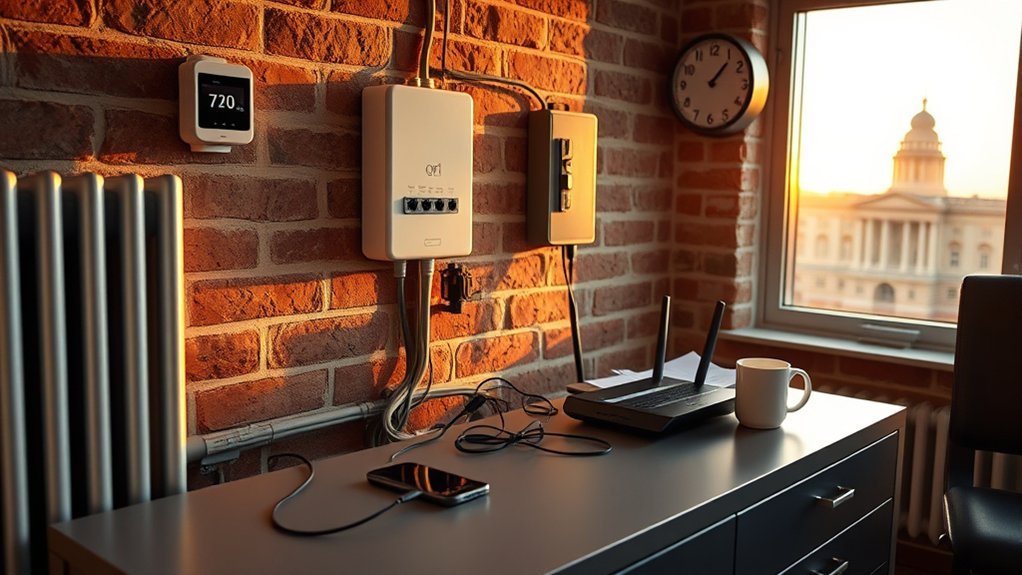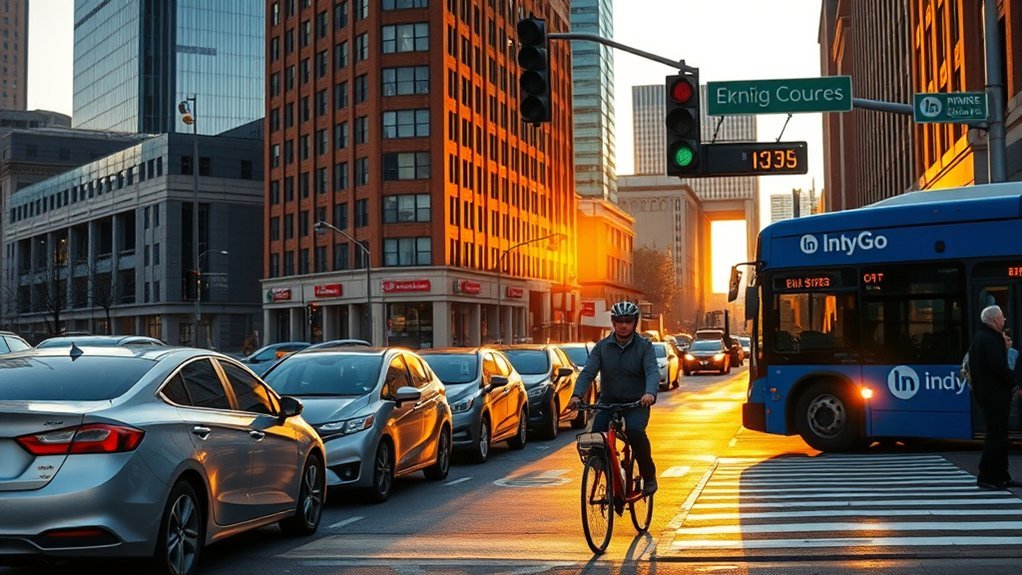You might not know Indianapolis’s overall cost of living is about 10.9% below the U.S. average, yet monthly rent still averages around $1,259 — much lower than many cities. You’ll see how that gap affects groceries, utilities, healthcare, and commuting, and what salary actually gives you breathing room. Keep going to get precise monthly figures and practical budget targets.
Cost of Living Snapshot for Indianapolis in 2025

In 2025, Indianapolis remains particularly affordable: overall costs run about 10.9% below the national average. You’ll find a clear Cost and Living advantage when budgeting here.
Average rent sits near $1,259 monthly, roughly 32.1% lower than the national average, so your rent dollars stretch further. If you own, housing-related expenses measure lower too, with homeowner costs around $7,433 per month, about 11.9% below national benchmarks.
Average rent near $1,259 — about 32% below average — and homeowner costs roughly $7,433 monthly, ~12% lower.
Utilities average $370.74 per month, approximately 10.3% under the national average, reducing monthly bill volatility. Grocery spending is modest: renters typically spend about $681 monthly, homeowners about $1,352, both roughly 1.7% below the national average.
Taken together, these figures mean you can plan a practical monthly budget with confidence: lower rent and utilities drive most savings, groceries provide marginal relief, and overall Living costs make Indianapolis an affordable option for many households.
Housing: Rent, Mortgage Rates, and Home Prices

Now that you’ve seen the overall cost advantages in Indianapolis, housing is where those savings show up most: average monthly rent is about $1,259 (32.1% below the national average), while the typical home lists around $364,401 with an average sale price near $360,369—roughly 23–30% cheaper than U.S. norms.
If you’re weighing renting vs buying, note the average rent is low relative to national benchmarks, and housing expenses for renters average about $4,344/month—8.8% under the U.S. figure.
Homeownership brings higher monthly housing expenses, with homeowners averaging roughly $7,433/month, largely driven by a current mortgage rate near 7.30% that raises principal-and-interest payments.
The average listing price at about $364,401 confirms home prices remain cheaper than the U.S., giving you purchasing power.
In short, living in Indianapolis delivers lower average rent and competitive home prices, but higher mortgage rates mean you should model monthly housing expenses carefully before you commit.
Monthly Utilities and Communication Expenses

You’ll want to budget about $370.74 per month for utilities and communications in Indianapolis, which combines average energy, phone, and internet costs.
Energy and heating typically run about $169.58 monthly—roughly 10.3% below the national average—while basic apartment utilities average $225.74 with an additional ~$145 for phone and internet.
Energy and Heating Costs
Expect to pay roughly $370.74 a month for basic utilities in Indianapolis for a 915-square-foot apartment, with about $169.58 of that going to energy—around 12% below the national average.
You’ll find the average monthly energy bill drives seasonal swings in utility costs; heating needs in winter can push your monthly utility expenses noticeably higher.
For budgeting, treat energy and telecommunications as core basic services: energy (~$169.58) plus typical phone and internet add roughly $145 to utility costs.
Note the reported average monthly phone bill of $192.42 can further affect your totals if you choose premium plans.
Track consumption, insulate where possible, and compare rates to keep these line items predictable within your overall monthly budgets.
Phone and Internet
After tracking energy use and weather-driven heating spikes, don’t forget how phone and internet charges shape your monthly utilities.
You’ll see the phone bill drives a large share — about $192.42 monthly — while basic phone and internet combined average roughly $145. That positions the total average monthly utility cost near $370.74 for a typical household.
For a standard 915-square-foot apartment, monthly utility cost averages about $225.74 including essential services like internet and phone.
Compared with other cities, utilities in Indianapolis are about 12% lower than the national average, so your communication expenses tend to be more affordable.
Use these figures when modeling your monthly budget to allocate realistic funds for connectivity.
Monthly Utility Breakdown
While seasonal changes push some bills up, your monthly utility picture in Indianapolis stays relatively affordable: a typical 915-square-foot apartment averages about $225.74 for essentials like electricity, heating, and water. This monthly utility breakdown shows essential services and how telecommunications expenses raise total monthly utility costs to roughly $370.74 when you add phone and internet. Average energy bills sit near $169.58 — about 12% below the national average — but heating needs can spike that in winter. Use the table to compare line items and plan a budget; knowing the numbers helps you control spending and prioritize efficiency upgrades or plan for higher winter costs.
| Item | Typical Monthly |
|---|---|
| Essential services | $225.74 |
| Energy bills | $169.58 |
| Telecom (basic) | $145.00 |
| Total avg cost | $370.74 |
Grocery and Food Budget Estimates

Because Indianapolis’ grocery prices trend slightly below the national average, you can plan a monthly food budget that reflects that affordability: renters spend about $681 and homeowners roughly $1,352 on groceries, with staples like a gallon of milk at $4.67, a dozen eggs at $3.40, potatoes at $4.52 per pound, and bread at $3.70.
With a lower cost of living, grocery costs run about 1.7% under the U.S. norm, so your monthly budget can allocate more to other essentials or savings.
Expect an average meal at an inexpensive restaurant to be around $25, which keeps dining out moderate.
When you map food expenses, break costs into groceries, occasional dining, and pantry essential items; use the renter/homeowner figures as guides.
For planning, track a two-week grocery list to scale monthly spend, prioritize versatile staples, and compare local stores. That approach helps you leverage Indianapolis as an affordable location without sacrificing meal quality.
Healthcare and Childcare Costs

Food costs are only part of your monthly picture; healthcare and childcare can quickly change what’s affordable.
In Indianapolis, healthcare in Indianapolis is relatively affordable — a doctor visit averages $112.66, a dentist $105.53, and an optometry check-up about $77.80, roughly 13% below national averages. Your annual health expenditure will vary: expect about $3,241 for a single adult and $9,598 for a family of four. That translates into an average monthly healthcare burden you should budget for alongside other household costs.
Child Care is a major line item. For registered Family Child Care Homes, the average annual cost is roughly $13,645 for one child and $24,388 for two.
Those figures, combined with healthcare, contribute to financial strain noted by ALICE benchmarks, showing household costs exceed the Federal Poverty Level. Plan monthly allocations for premiums, copays, and child care fees so you avoid surprises and keep your budget realistic.
Transportation, Commuting, and Auto Expenses

If you drive, commute costs will eat a sizable slice of your budget: expect about $10,627 per year for a single adult and roughly $17,825 for a family of four in Indianapolis.
Those annual transportation cost figures include gasoline, maintenance, insurance and routine vehicle upkeep. Gasoline prices hover around $3.35 per gallon, so your weekly fill-ups and longer trips quickly add up.
Annual transport costs cover gas, maintenance, insurance and routine upkeep — with gas around $3.35 per gallon.
If you prefer public transportation, IndyGo charges $1.75 for a two-hour transfer ticket or $60 for a 31-day pass — a clear tradeoff against owning a car.
Commuting choices affect your household budget directly; driving raises expenses and adds unpredictability from fuel and maintenance, while transit lowers outlays but may extend travel time.
Also factor in related monthly utility bills and connectivity: average utilities for a 915-sq-ft apartment are about $225.74, plus roughly $145 for phone and internet.
Compare costs by mode to decide which mix of transportation and commuting works best for your budget.
What Salary You Need to Live Comfortably in Indianapolis

Now that you’ve seen how housing, utilities and commuting bite into a monthly budget, let’s look at what salary actually lets you live comfortably in Indianapolis.
To match the area’s cost of living index and live without constant strain, aim for a median household income near $42,704; that aligns with typical expenses.
Rent for a two-bedroom apartment averages $1,294.70, monthly grocery expenses run about $681 for a single adult (or $1,352 for a family of four), transportation costs average $386, and average utility costs are roughly $370.74.
When you total housing, groceries, transportation and utilities, you’ll see why budgeting for essential services is vital.
So how much salary do I need? Target a take-home that covers 30–35% for rent plus the listed essentials, meaning gross annual pay around $42k–$50k gives comfortable breathing room.
If you have dependents or higher savings goals, plan toward the upper end.
Frequently Asked Questions
What’s the Average Cost of Living in Indianapolis?
You’ll pay about 10.9% less than the U.S. average; typical rent is ~$1,259. Consider cost factors: housing market, transportation expenses, grocery prices, utility bills, healthcare costs, entertainment options, education expenses when budgeting.
How Much Money Do You Need to Live Comfortably in Indianapolis?
Like a steady metronome, you’ll need about $3,000 monthly to live comfortably; factor affordable neighborhoods, grocery expenses, transportation costs, utility bills, healthcare expenses, dining out, entertainment budget, and savings goals into that practical, data-driven total.
What Is the Average Cost of Living per Month in Indiana?
You’d spend about $1,800–$2,500 monthly in Indiana, covering Indiana housing, utility expenses, transportation costs, food prices, healthcare affordability, education expenses, entertainment budget, and savings strategies; adjust based on location, household size, and lifestyle choices.
How Much Should a Person Make in Indianapolis to Afford Rent for a One Bedroom Apartment?
You’ll need about $51,400 annually to afford one-bedroom rent in Indianapolis. That figure aids rent affordability, salary expectations, housing market analysis, cost analysis, budget planning, income requirements, apartment types and practical financial stability.
Conclusion
You’ll find Indianapolis offers clear savings: rent averages $1,259 monthly (32.1% below the national average), groceries run about $681 for renters, and utilities plus communication add roughly $371 — overall cost of living sits 10.9% under the U.S. mark. With these numbers, you can plan a realistic monthly budget, save more, or enjoy extras; picture your dollars stretching farther here, a literal and practical breath of financial relief.



2 thoughts on “Average Living Cost in Indianapolis: Monthly Budget, Rent & Essentials”
Pingback: Cost Of Living In Boston : Complete Monthly Budget Guide
Pingback: Average Living Cost In Oklahoma City: Monthly Budget, Rent & Essentials